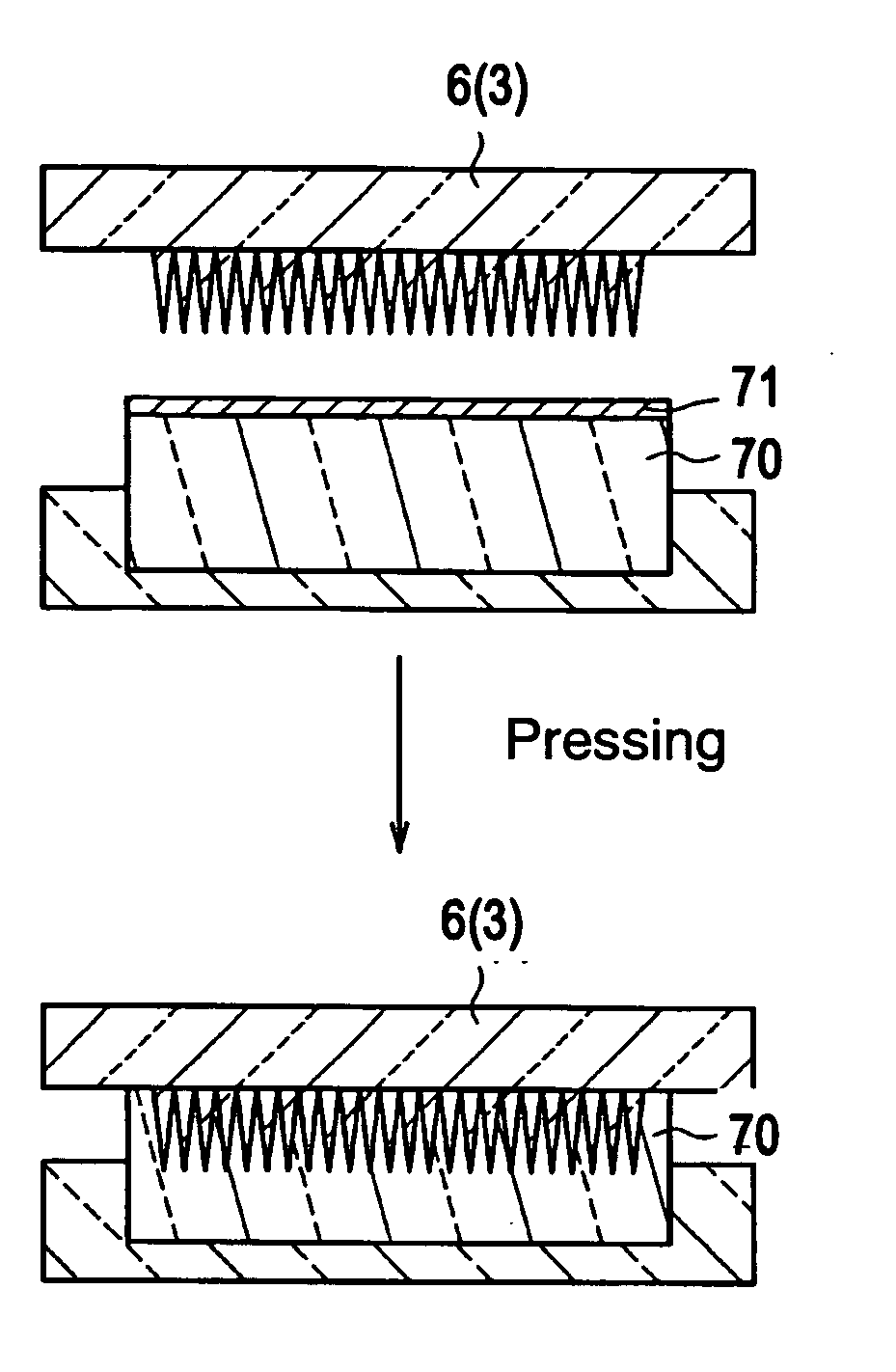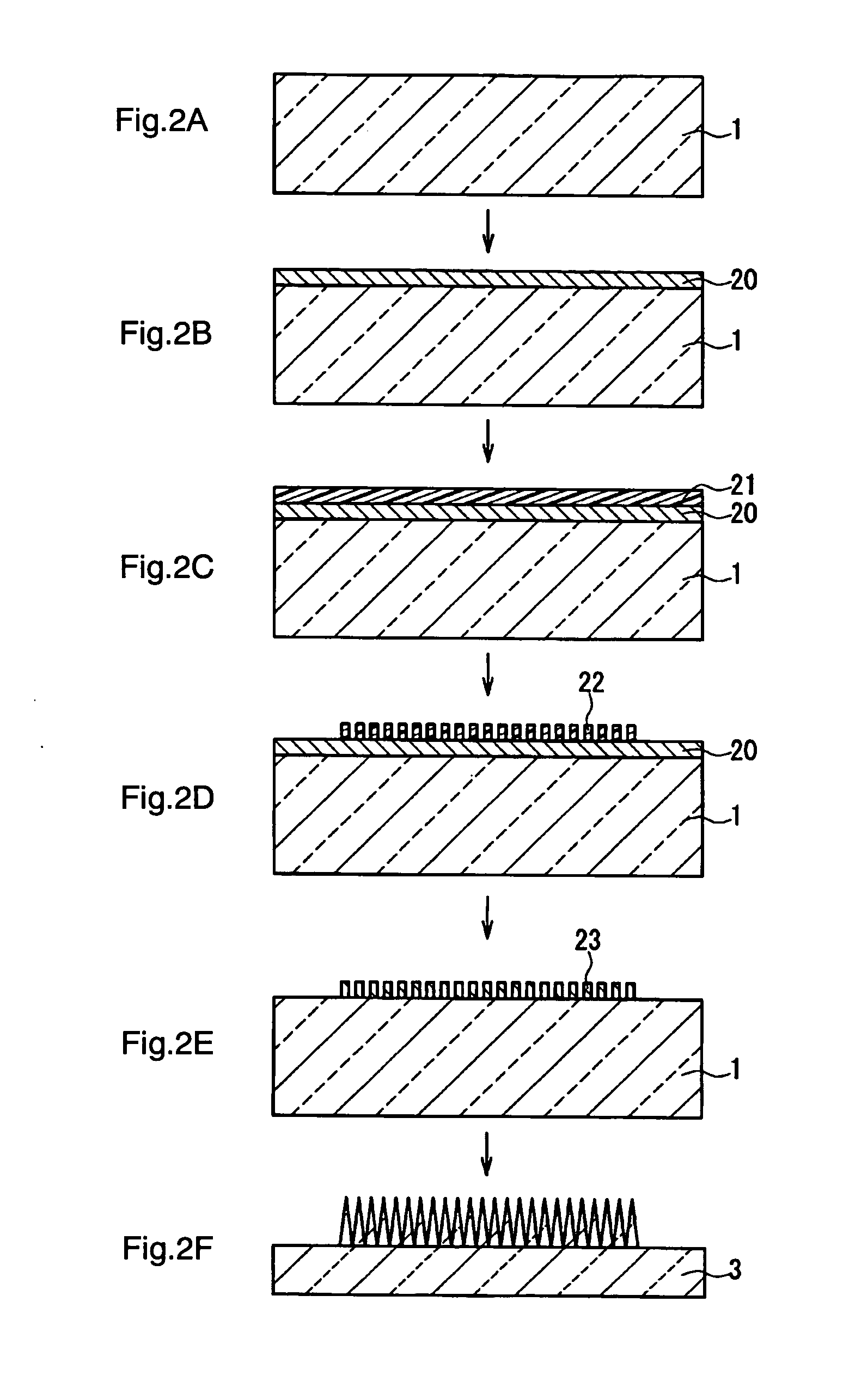Method for producing optical element having antireflection structure, and optical element having antireflection structure produced by the method
a technology of anti-reflection structure and optical element, which is applied in the direction of electric/magnetic/electromagnetic heating, hollow wall articles, instruments, etc., can solve the problems of low etching rate, and limited optical material that can be used
- Summary
- Abstract
- Description
- Claims
- Application Information
AI Technical Summary
Benefits of technology
Problems solved by technology
Method used
Image
Examples
first embodiment
[0034] This embodiment will be described by taking a plate optical element having a cone-shaped microstructure of a pitch of 0.15 μm and a depth of 0.15 μm at one face as an example of the optical element having an antireflection structure of the present invention.
[0035]FIG. 1 is a cross-sectional view showing a mold for press-molding an optical element having an antireflection structure in the first embodiment of the present invention.
[0036] In FIG. 1, reference numeral 1 denotes a quartz glass substrate of 20 mm×20 mm×5 mm. Quartz glass is a material that has excellent high temperature strength and heat resistance and whose surface is hardly roughened by dry-etching. In the surface (pressing surface) of the quartz glass substrate 1, a cone-shaped antireflection structure 2 having a pitch of 0.15 μm and a height of 0.15 μm is formed, and the quartz glass substrate 1 in which this antireflection structure 2 is formed is used as a mold 3 having an antireflection structure.
[0037] H...
second embodiment
[0051] In this embodiment, substantially the same mold as in the first embodiment was used as the mold for press-molding an optical element having an antireflection structure (see FIG. 1). The mold for press-molding in this embodiment is different from the mold for press-molding in the first embodiment in the following point. In this embodiment, when producing the mold 3 having an antireflection structure, a carbon (C) film for mold release having a thickness of 0.05 μm was formed on the surface (pressing surface) of the quartz glass substrate 1 provided with the cone-shaped antireflection structure 2, instead of forming an Ir—Rh alloy film for protecting the surface. For this reason, in this embodiment, unlike the first embodiment, a releasing agent is not applied onto the surface of the optical material 11 to be press-molded.
[0052] A method for producing the optical element 17 having an antireflection structure, using the mold 3 having an antireflection structure and the lower me...
third embodiment
[0055] In this embodiment, substantially the same mold as in the first embodiment was used as the mold for press-molding the optical element 17 having an antireflection structure (see FIG. 1).
[0056] The process for molding the optical element 17 having an antireflection structure is substantially the same as that in the first embodiment. The molding process in this embodiment is different from the molding process in the first embodiment in the following point. In this embodiment, the optical element 17 having an antireflection structure is molded while N2 and CO2 (10 vol. %) was introduced from an atmosphere gas inlet 18 of the chamber 15 to the inside of the molding machine.
[0057] When the optical element 17 having an antireflection structure was molded in the atmosphere as above, it was found that an optical element 17 having a highly precise antireflection structure without pattern dislocation over the entire area of 15 mm×15 mm of the optical material 11 could be molded repeat...
PUM
| Property | Measurement | Unit |
|---|---|---|
| Thickness | aaaaa | aaaaa |
| Diameter | aaaaa | aaaaa |
| Height | aaaaa | aaaaa |
Abstract
Description
Claims
Application Information
 Login to View More
Login to View More - R&D
- Intellectual Property
- Life Sciences
- Materials
- Tech Scout
- Unparalleled Data Quality
- Higher Quality Content
- 60% Fewer Hallucinations
Browse by: Latest US Patents, China's latest patents, Technical Efficacy Thesaurus, Application Domain, Technology Topic, Popular Technical Reports.
© 2025 PatSnap. All rights reserved.Legal|Privacy policy|Modern Slavery Act Transparency Statement|Sitemap|About US| Contact US: help@patsnap.com



